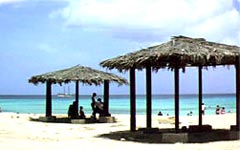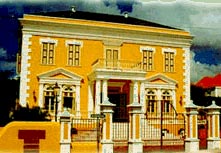AN INTRODUCTION
TO CURAÇAO
 Famous for
its fine liqueur made from the sweetened peel of bitter oranges
and for its sunny climate and secluded beaches, Curaçao
has a rich and diverse history, which explains the international
flavor of its culture and the curious mixture of Old and
New World charm. The people claim descent from over 50 different
ethnic backgrounds, and the native language, Papiamentu,
is
a creole mixture of Dutch, Portuguese, Spanish, English,
French, African, and some Arawak Indian. Famous for
its fine liqueur made from the sweetened peel of bitter oranges
and for its sunny climate and secluded beaches, Curaçao
has a rich and diverse history, which explains the international
flavor of its culture and the curious mixture of Old and
New World charm. The people claim descent from over 50 different
ethnic backgrounds, and the native language, Papiamentu,
is
a creole mixture of Dutch, Portuguese, Spanish, English,
French, African, and some Arawak Indian.
Curaçao's strategic position at the base of the Caribbean
has also made it an important crossroads for global commerce
and connected the tiny island with many of the important persons
and events in world affairs. Amerigo Vespucci, Alonso de Ojeda,
Peter Stuyvesant, the notorious Captain Bligh, Simon Bolivar
were all drawn into Curaçao's colorful past.
 Today however, it is mainly the sun and the natural beauty
that bring people here. With an average rainfall of less than
22 inches a year, the weather is almost guaranteed to be sunny
all the time, and the constant tradewinds help to keep the
island cool. There are 38 different beaches to choose from
-- some that are sheltered by towering cliffs, others with
deep caves created by the pounding surf, and still others with
wide expanses and modern facilities. Today however, it is mainly the sun and the natural beauty
that bring people here. With an average rainfall of less than
22 inches a year, the weather is almost guaranteed to be sunny
all the time, and the constant tradewinds help to keep the
island cool. There are 38 different beaches to choose from
-- some that are sheltered by towering cliffs, others with
deep caves created by the pounding surf, and still others with
wide expanses and modern facilities.
Or for the more actively inclined,
there are ample opportunities to experience the natural wonders
up close. Curaçao
has long been overlooked by diving enthusiasts, but the national
Underwater Park is a 12.5 mile stretch of protected coral reef
with many attractions for even the most experienced of divers
and Klein Curaçao, a small uninhabited island off the
eastern coast, is well worth exploring. The marlin, sailfish,
tuna, and wahoo in the offshore waters provide excellent Deep
Sea Fishing, and the wildlife in the preserve at Christoffel
Park should be of interest to anyone who prefers to encounter
nature on dry land.
Curaçao is also a great spot
for bargain-hunters. The duty-free shopping makes for some
of the best deals in the
Caribbean on imported electronic equipment, china, crystal,
jewelry, linens, and perfume. The capital city of Willemstad
has an active social life with music festivals all year long,
dancing at the popular discotheques, and gambling in the hotel
casinos.
Location:
The largest and most populous of the
Netherlands Antilles, located in between Aruba and Bonaire,
Curaçao lies some
35 miles off the northern coast of Venezuela and 800 miles
north of the equator. The island is 38 miles long and varies
between 2 and 8 miles in width. Spectacular beaches line the
southwest, leeward coast. Geographically, it falls within the
Atlantic Standard Time Zone, which is one hour ahead of U.S.
Eastern Standard Time and the same as Eastern Daylight Time.
Its capital city is Willemstad.
Size:
The population numbers more than 170,000, most of whom are
of African or mixed African and European descent. In all,
more than 50 different ethnic backgrounds are represented
here,
and the people are very proud of the island's international
flavor. The native language is Papiamentu, but Curaçaoans
are multi-lingual, having learned to speak English, Dutch,
and Spanish at school from the third grade on.
Climate:
Curaçao lies well below the hurricane belt, so the climate
is sunny and dry, averaging only 22 inches of rainfall per
year. The rainy season occurs in November and December. Despite
the almost constant sunshine, the average year-round temperature
is only 82 degrees Fahrenheit (28 Celsius) due to the trade
winds that keep the island cool all the time. A hilly island
of volcanic origin, Curaçao supports a large variety
of tropical flora and fauna, most of which may be found in
Christoffel Park, a nature preserve located at the northern
tip around the island's highest point, Mt. Christoffel.
This page, and all contents of this Web site are Copyright
(c) 1997-2005 by InterKnowledge Corp. All rights reserved. |
